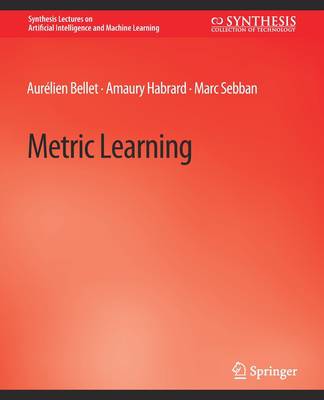
- Retrait gratuit dans votre magasin Club
- 7.000.000 titres dans notre catalogue
- Payer en toute sécurité
- Toujours un magasin près de chez vous
- Retrait gratuit dans votre magasin Club
- 7.000.000 titres dans notre catalogue
- Payer en toute sécurité
- Toujours un magasin près de chez vous
Description
Similarity between objects plays an important role in both human cognitive processes and artificial systems for recognition and categorization. How to appropriately measure such similarities for a given task is crucial to the performance of many machine learning, pattern recognition and data mining methods. This book is devoted to metric learning, a set of techniques to automatically learn similarity and distance functions from data that has attracted a lot of interest in machine learning and related fields in the past ten years. In this book, we provide a thorough review of the metric learning literature that covers algorithms, theory and applications for both numerical and structured data. We first introduce relevant definitions and classic metric functions, as well as examples of their use in machine learning and data mining. We then review a wide range of metric learning algorithms, starting with the simple setting of linear distance and similarity learning. We show how one may scale-up these methods to very large amounts of training data. To go beyond the linear case, we discuss methods that learn nonlinear metrics or multiple linear metrics throughout the feature space, and review methods for more complex settings such as multi-task and semi-supervised learning. Although most of the existing work has focused on numerical data, we cover the literature on metric learning for structured data like strings, trees, graphs and time series. In the more technical part of the book, we present some recent statistical frameworks for analyzing the generalization performance in metric learning and derive results for some of the algorithms presented earlier. Finally, we illustrate the relevance of metric learning in real-world problems through a series of successful applications to computer vision, bioinformatics and information retrieval. Table of Contents: Introduction / Metrics / Properties of Metric Learning Algorithms / Linear Metric Learning / Nonlinear and Local Metric Learning / Metric Learning for Special Settings / Metric Learning for Structured Data / Generalization Guarantees for Metric Learning / Applications / Conclusion / Bibliography / Authors' Biographies
Spécifications
Parties prenantes
- Auteur(s) :
- Editeur:
Contenu
- Nombre de pages :
- 139
- Langue:
- Anglais
- Collection :
Caractéristiques
- EAN:
- 9783031004445
- Date de parution :
- 12-02-15
- Format:
- Livre broché
- Format numérique:
- Trade paperback (VS)
- Dimensions :
- 190 mm x 235 mm
- Poids :
- 272 g







